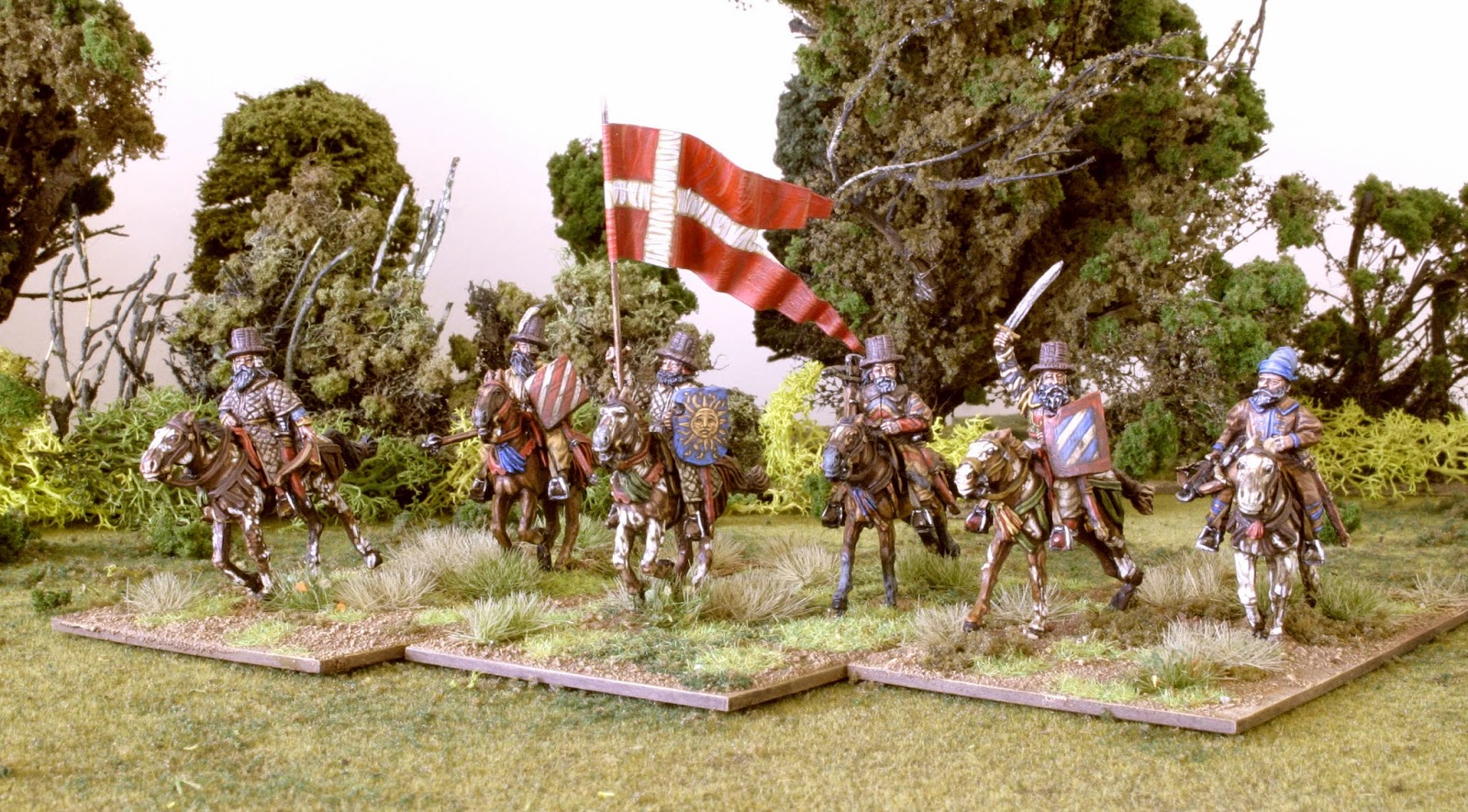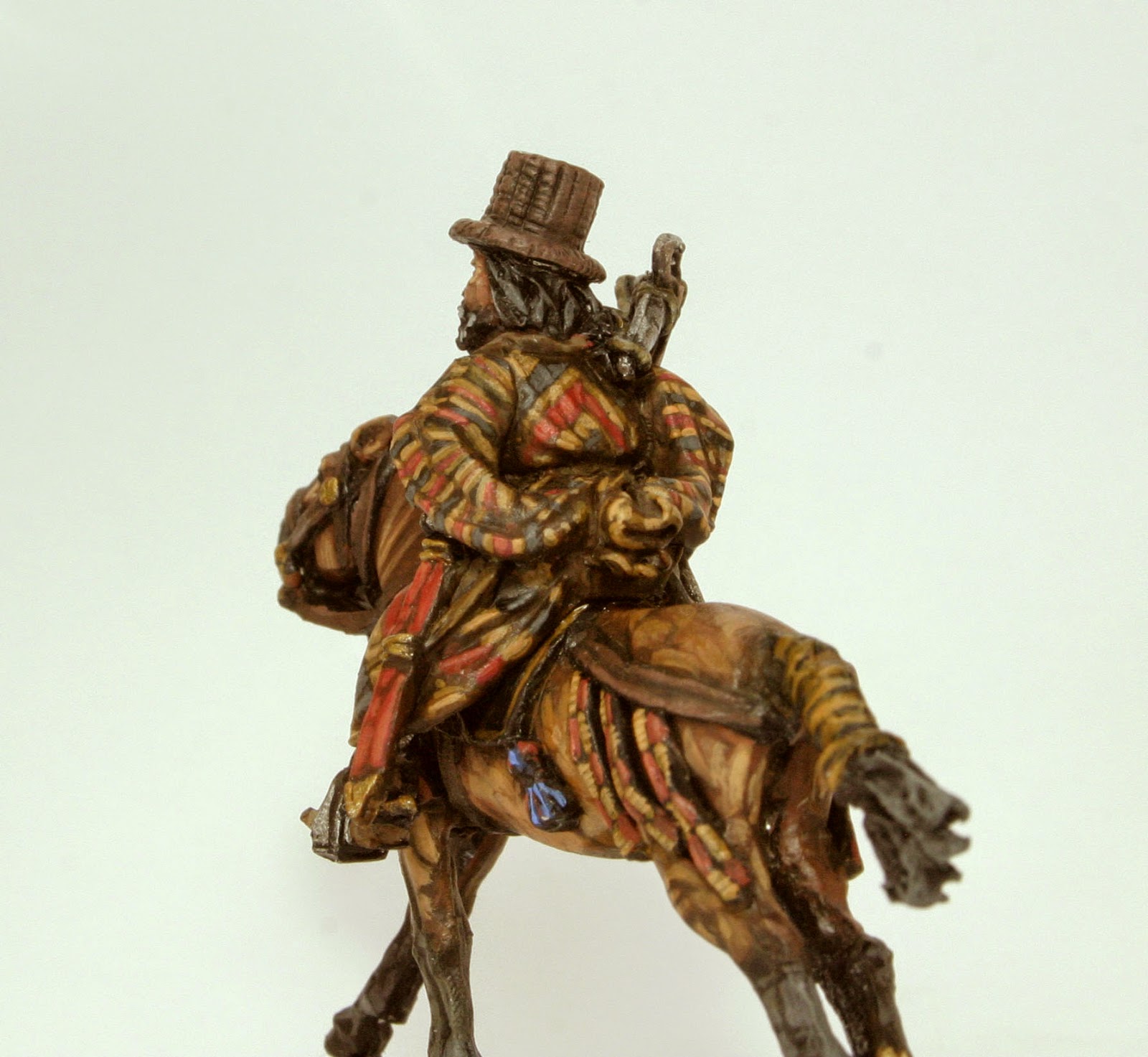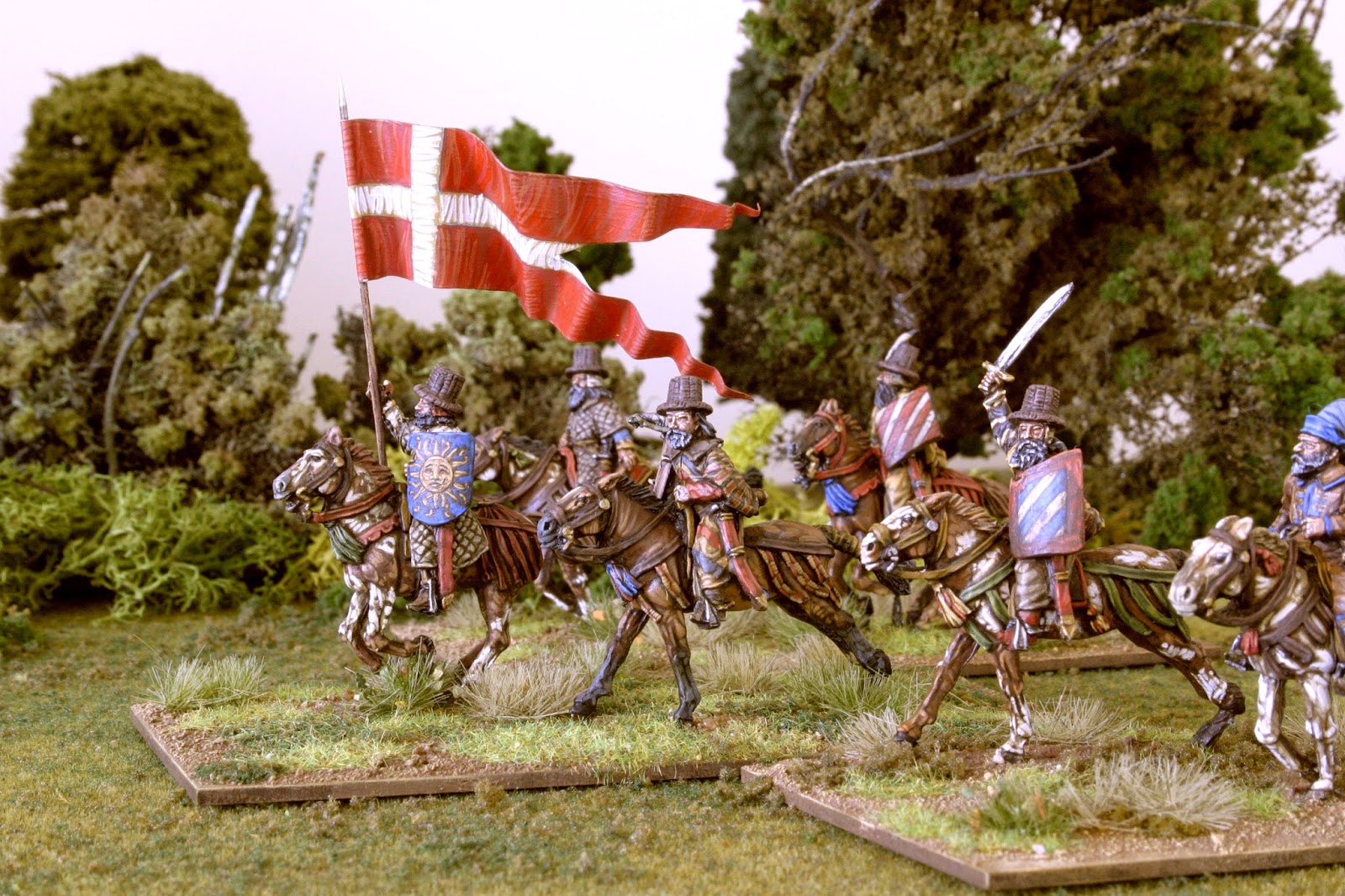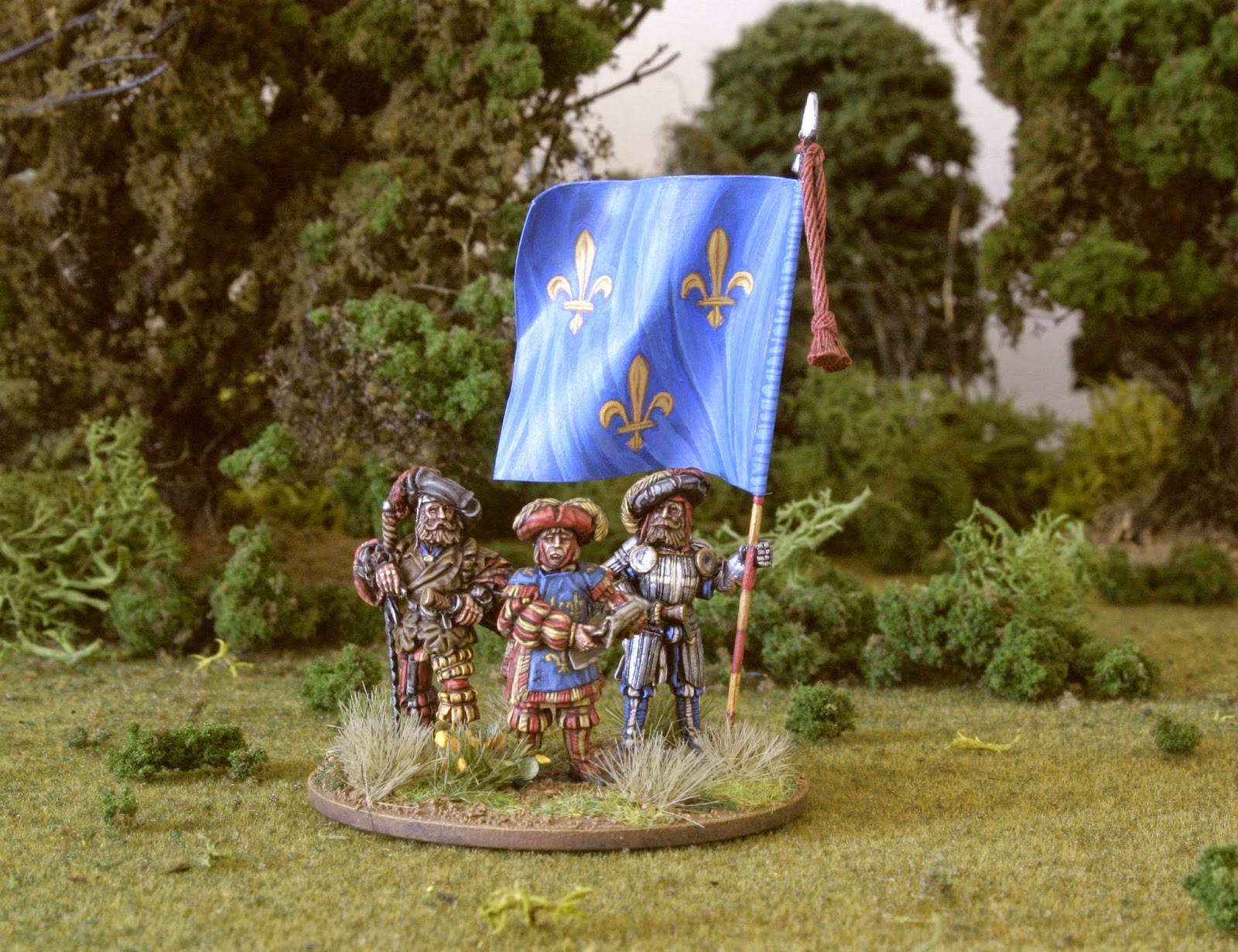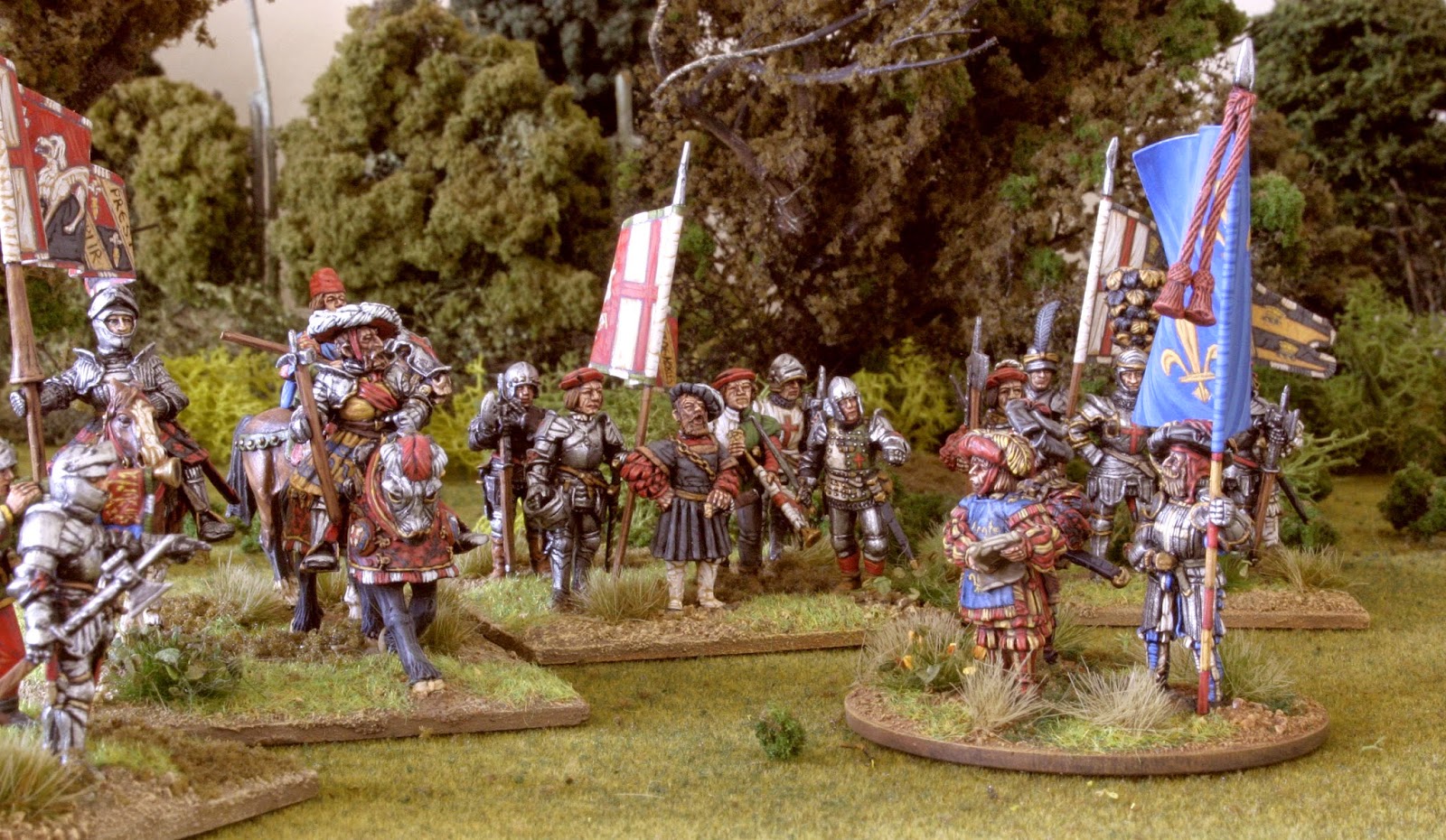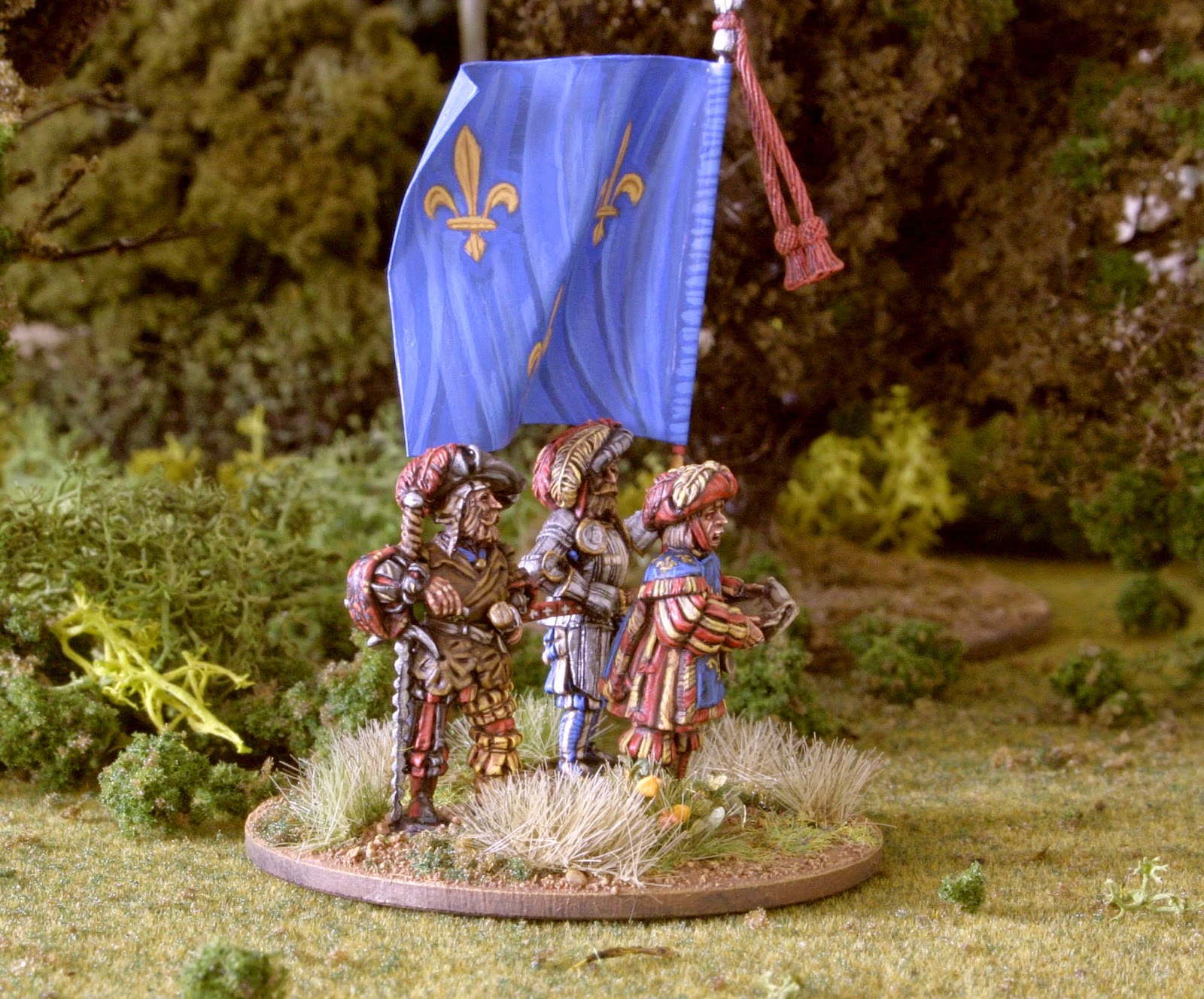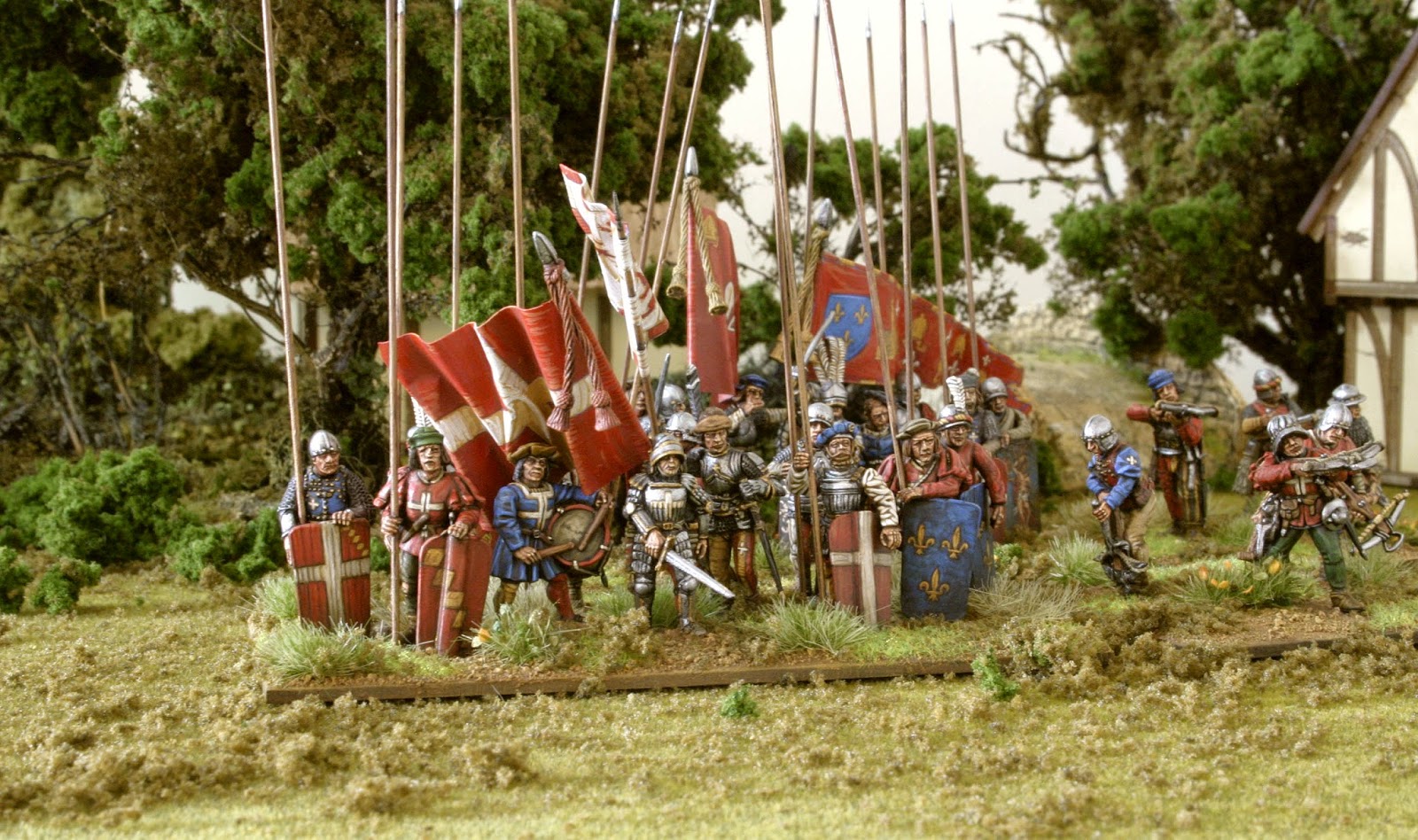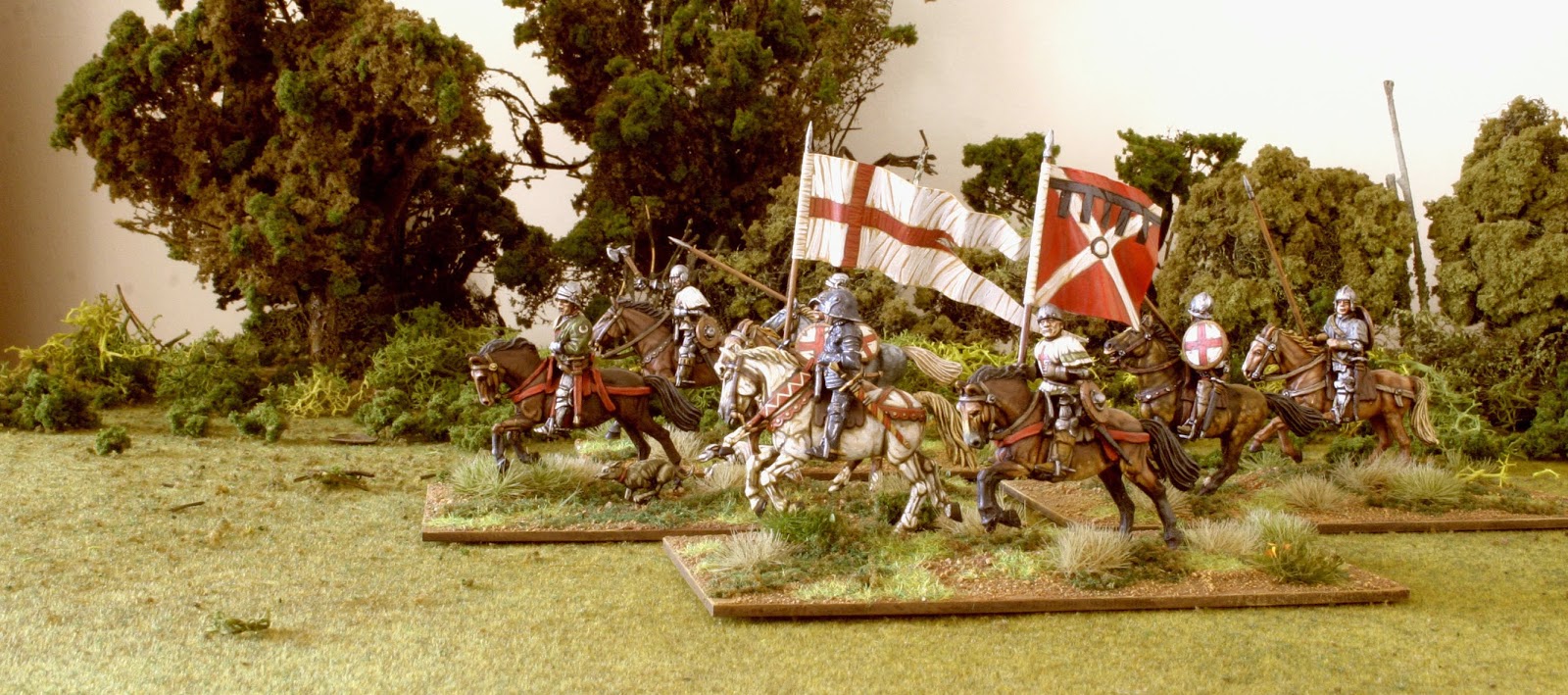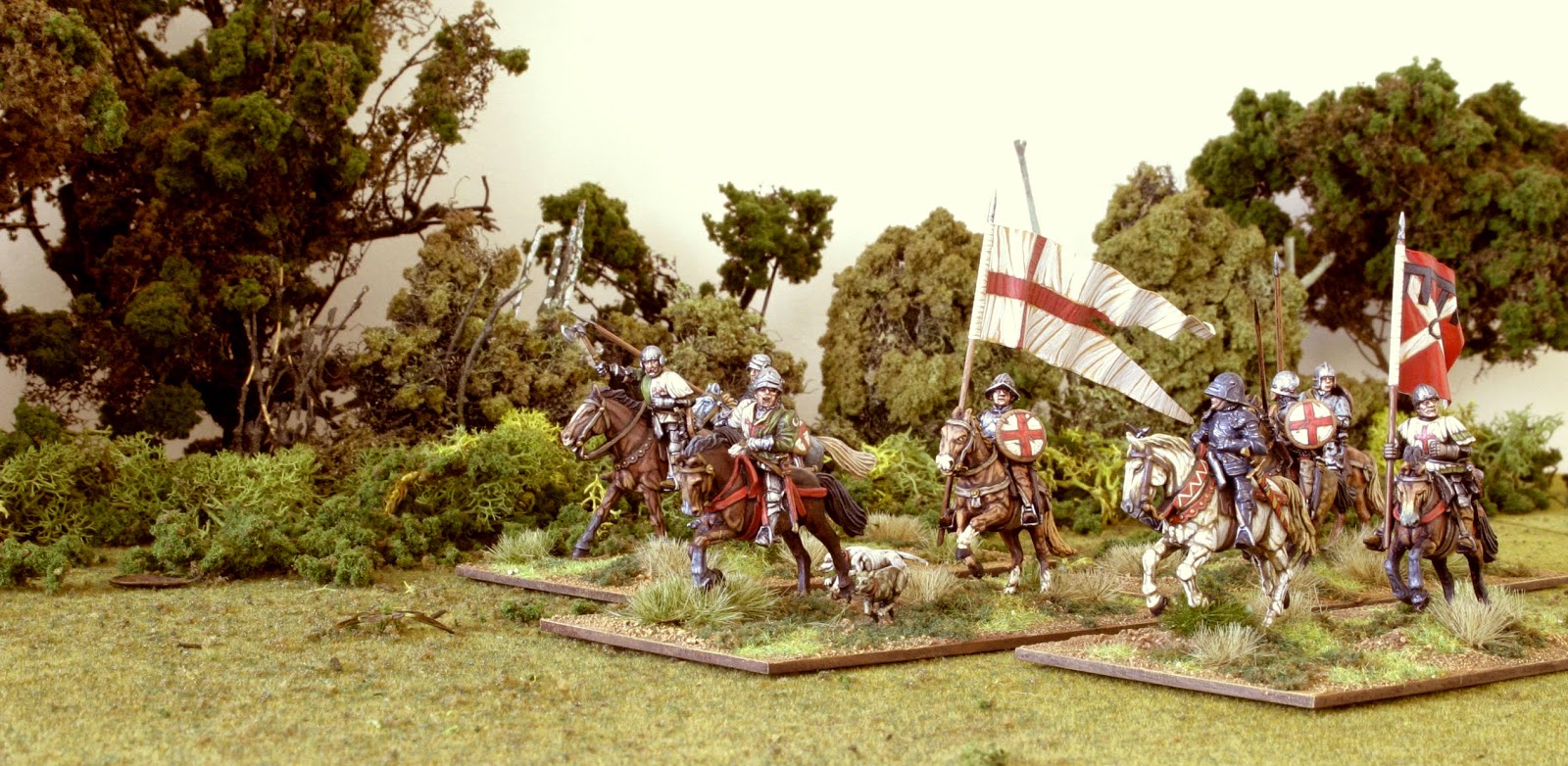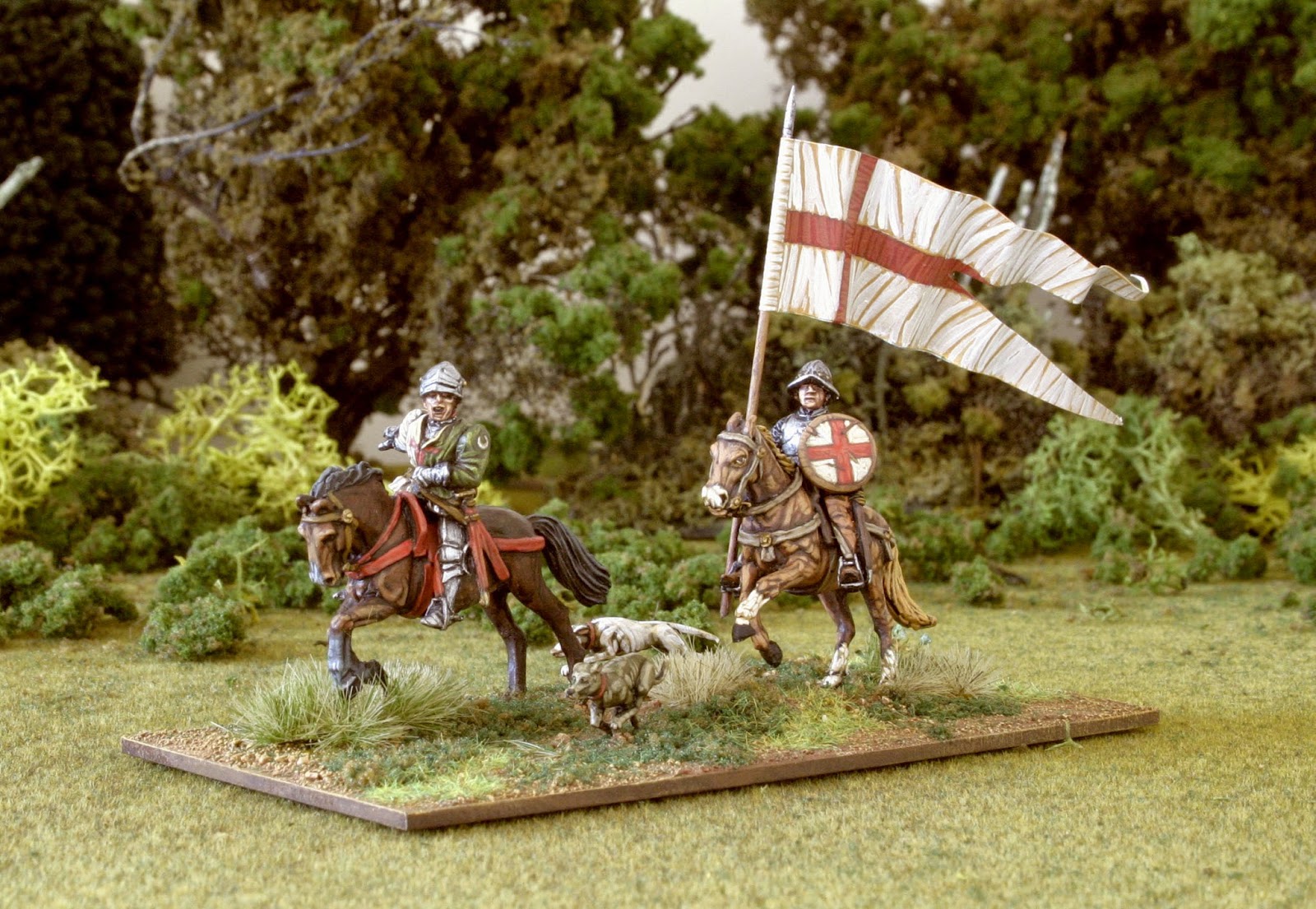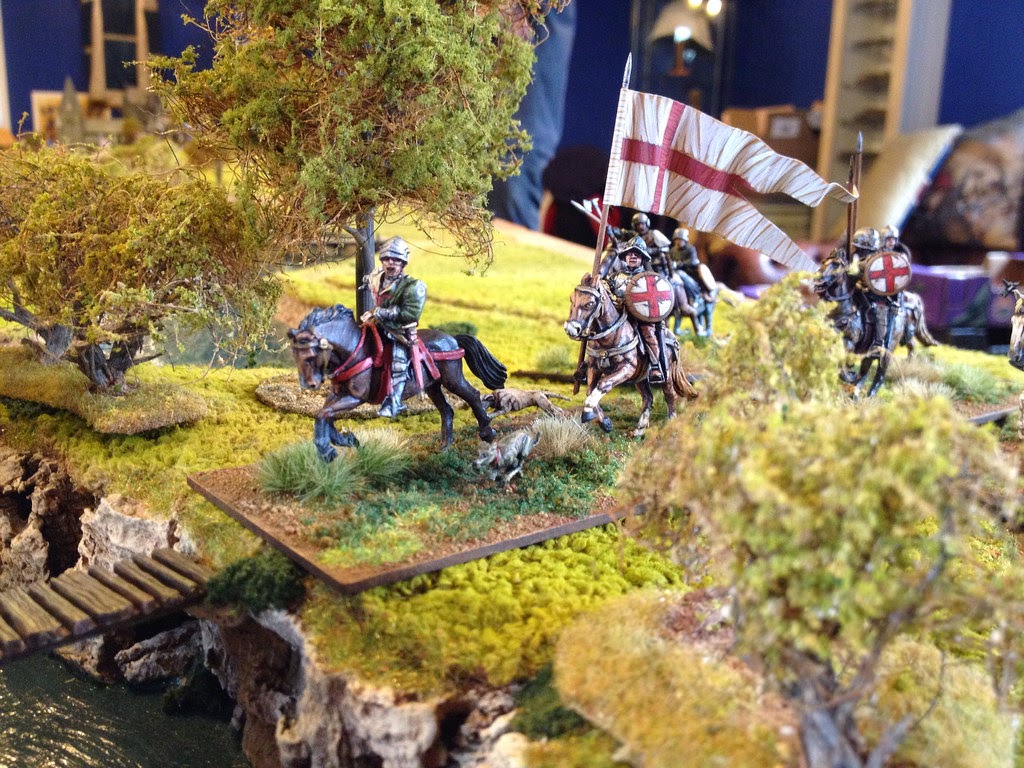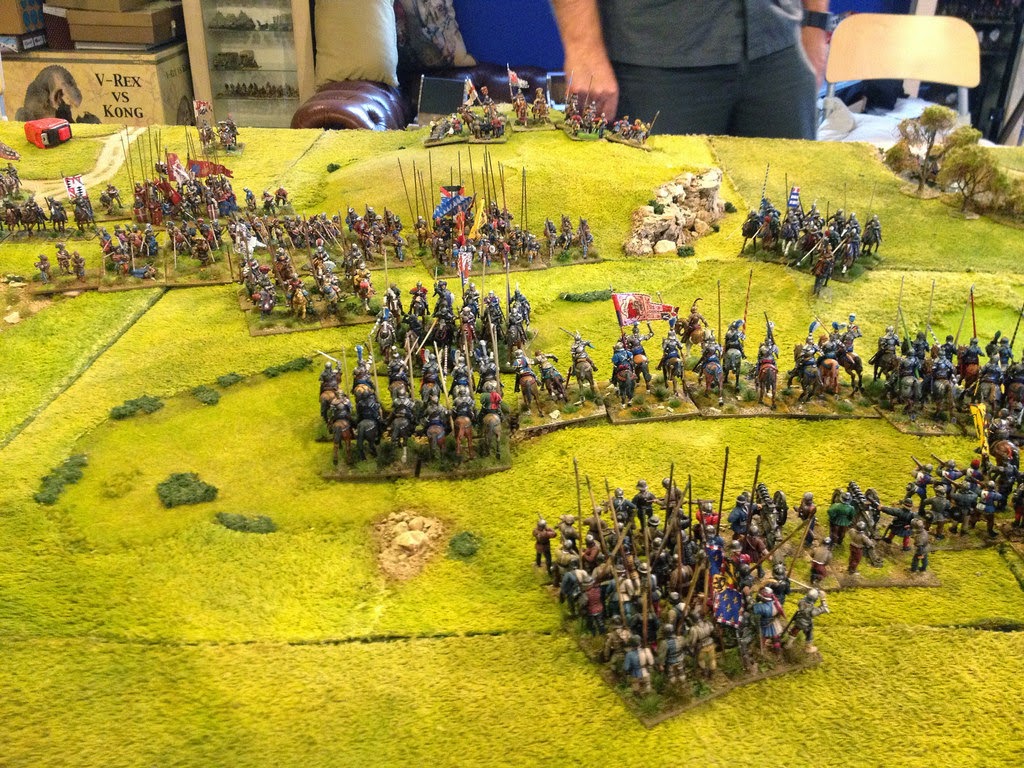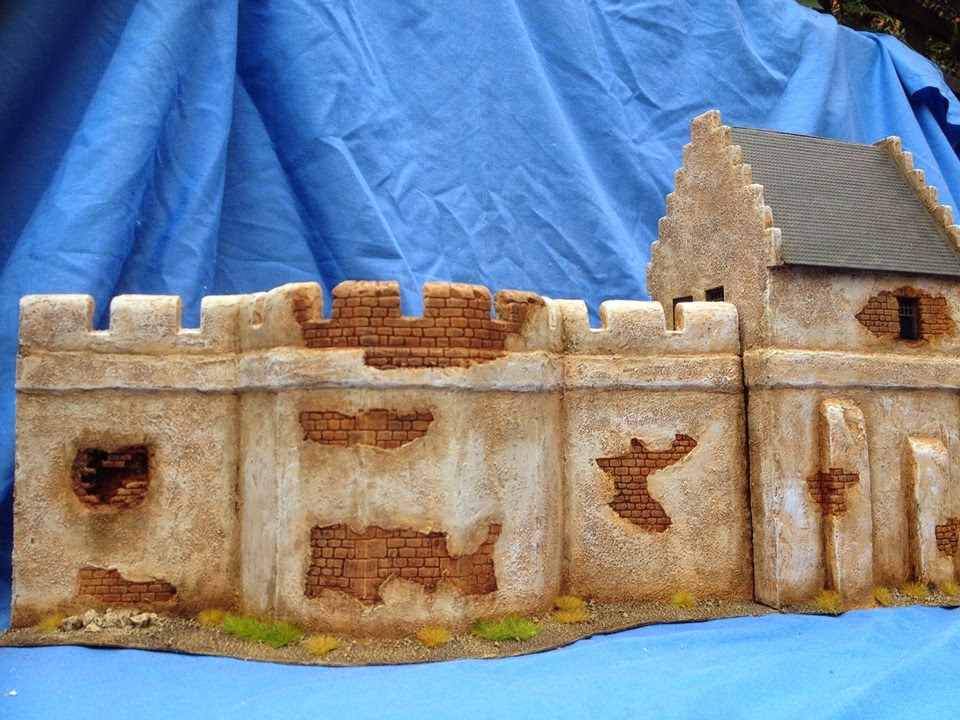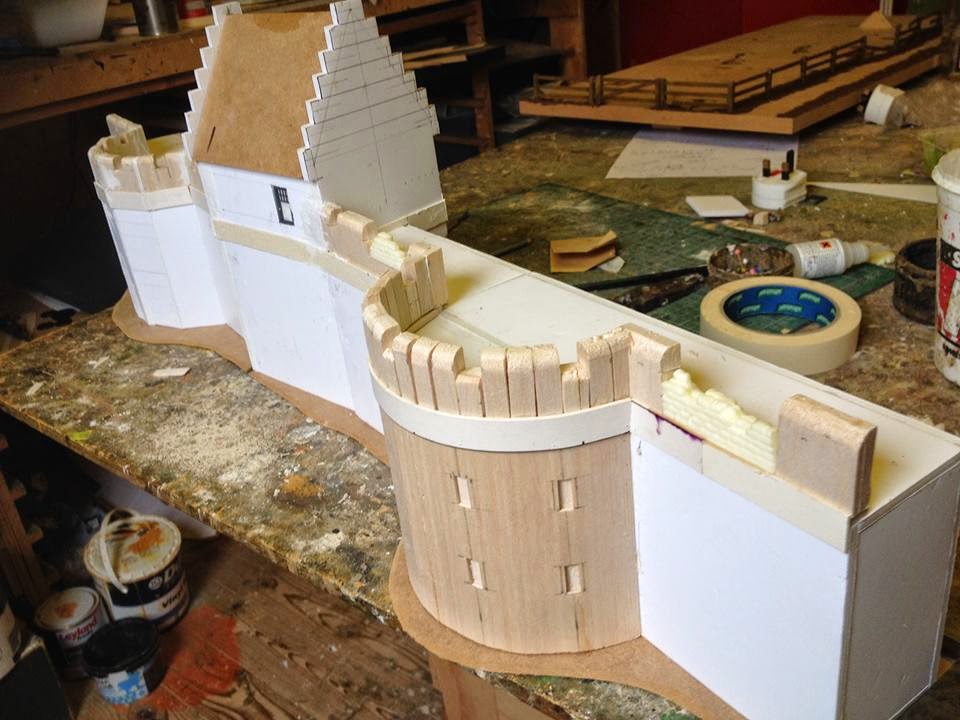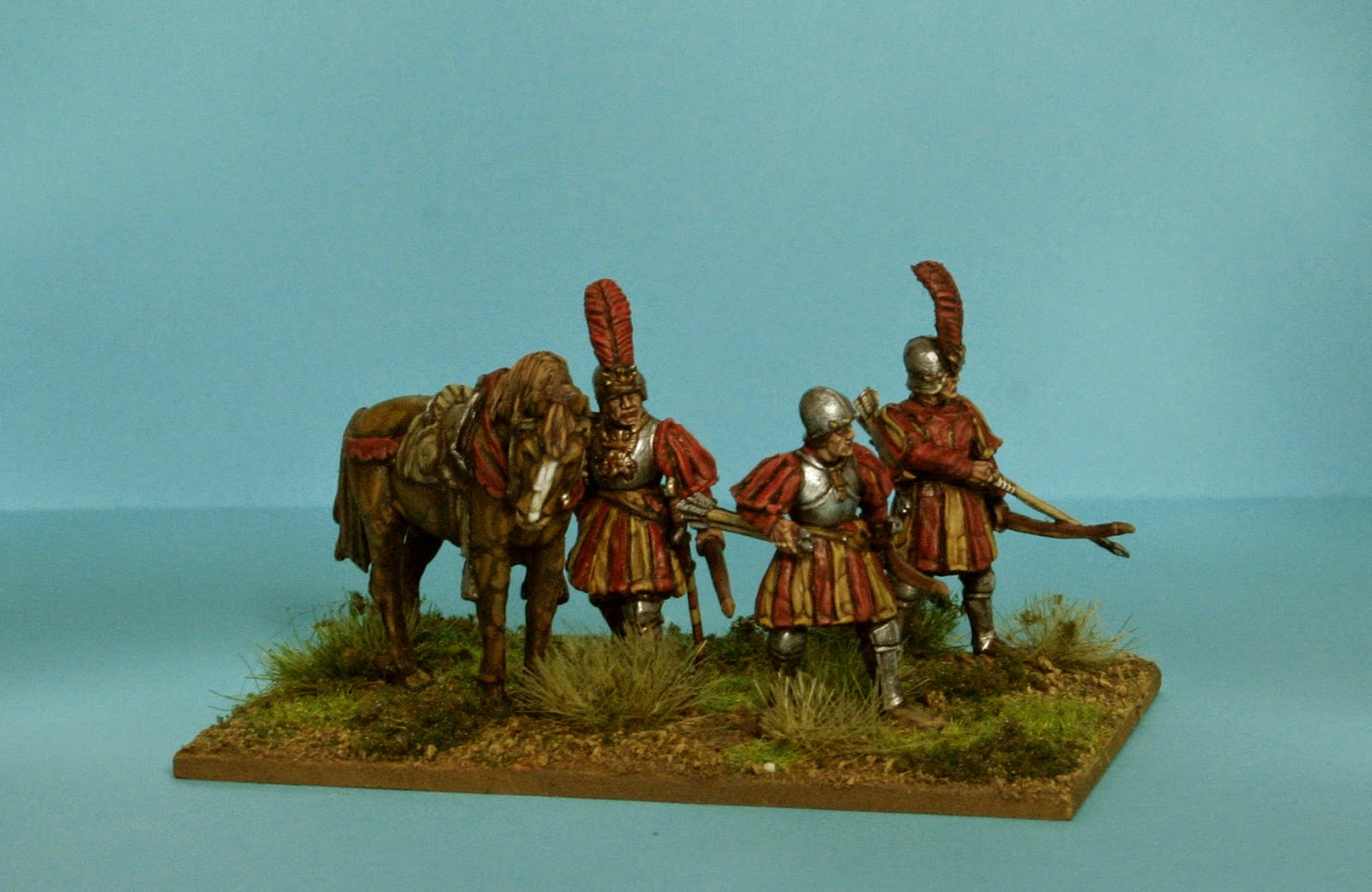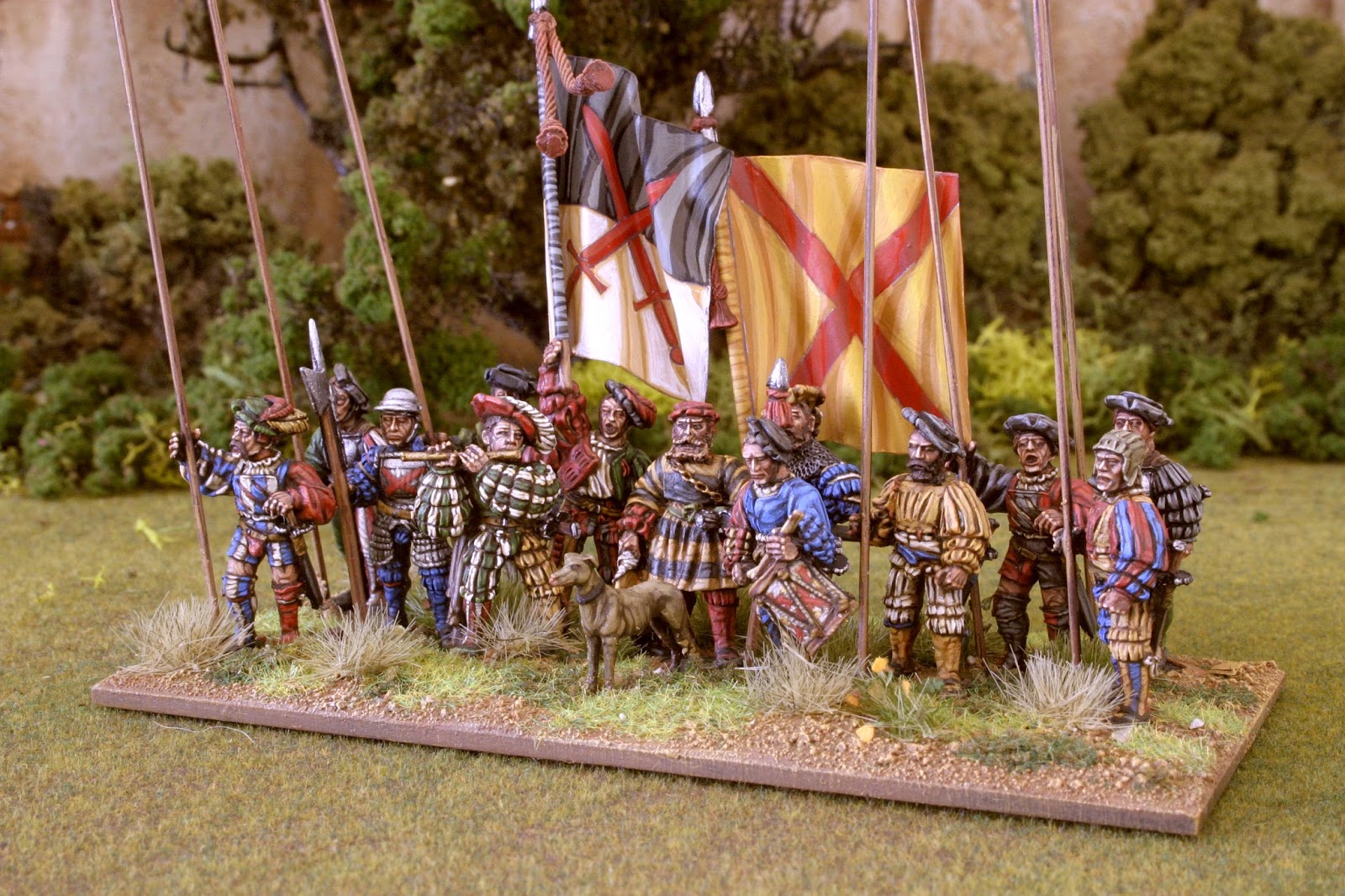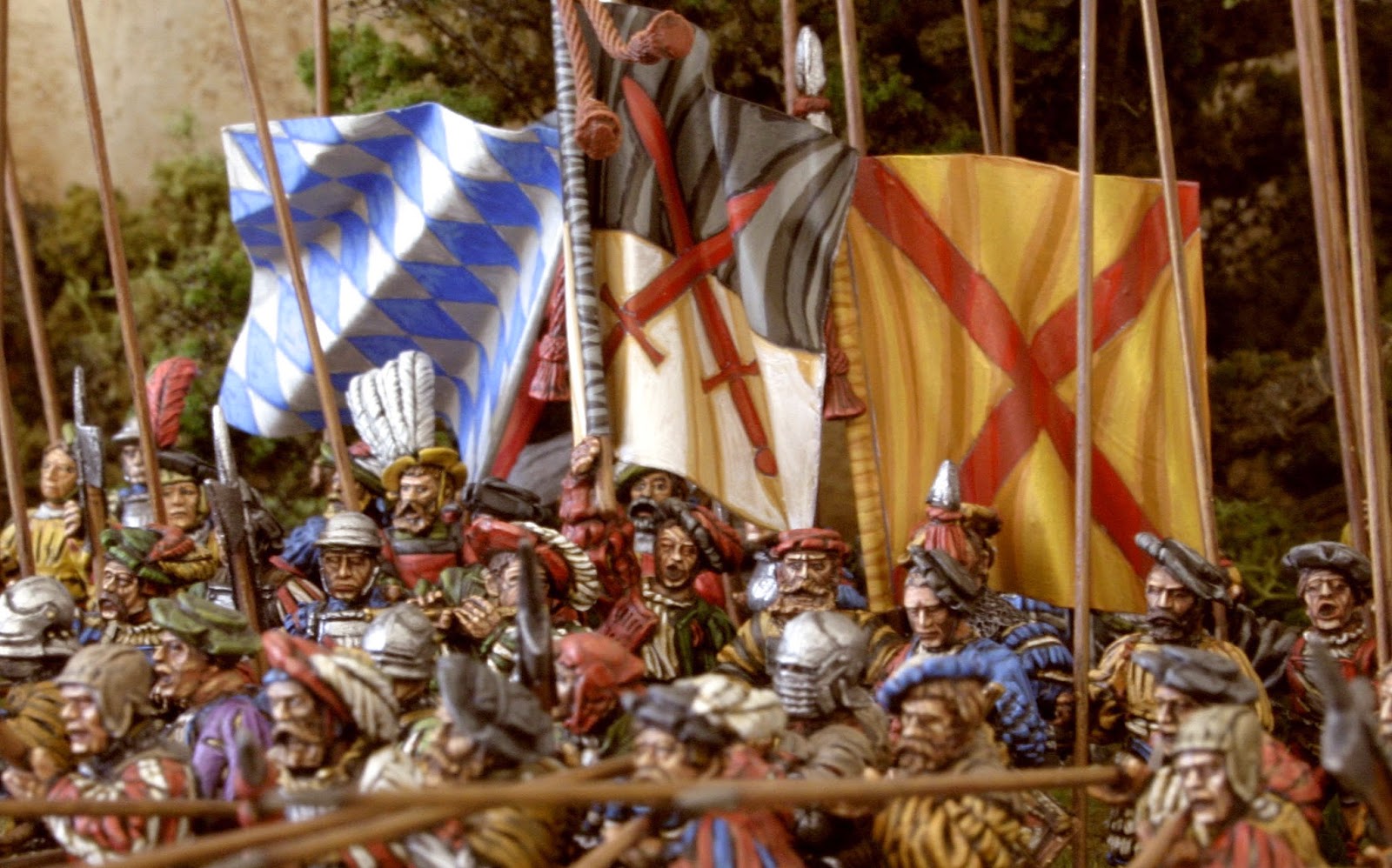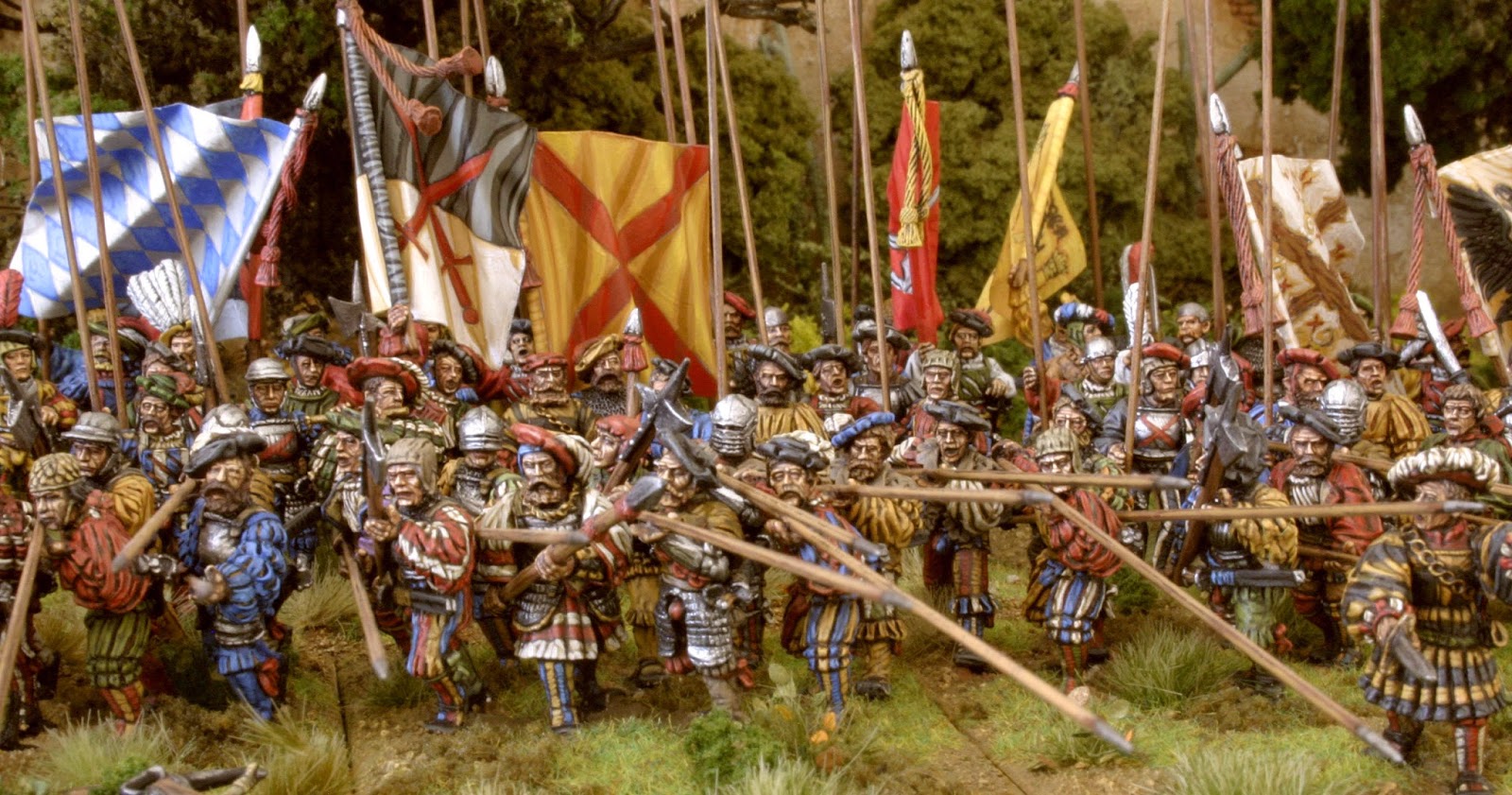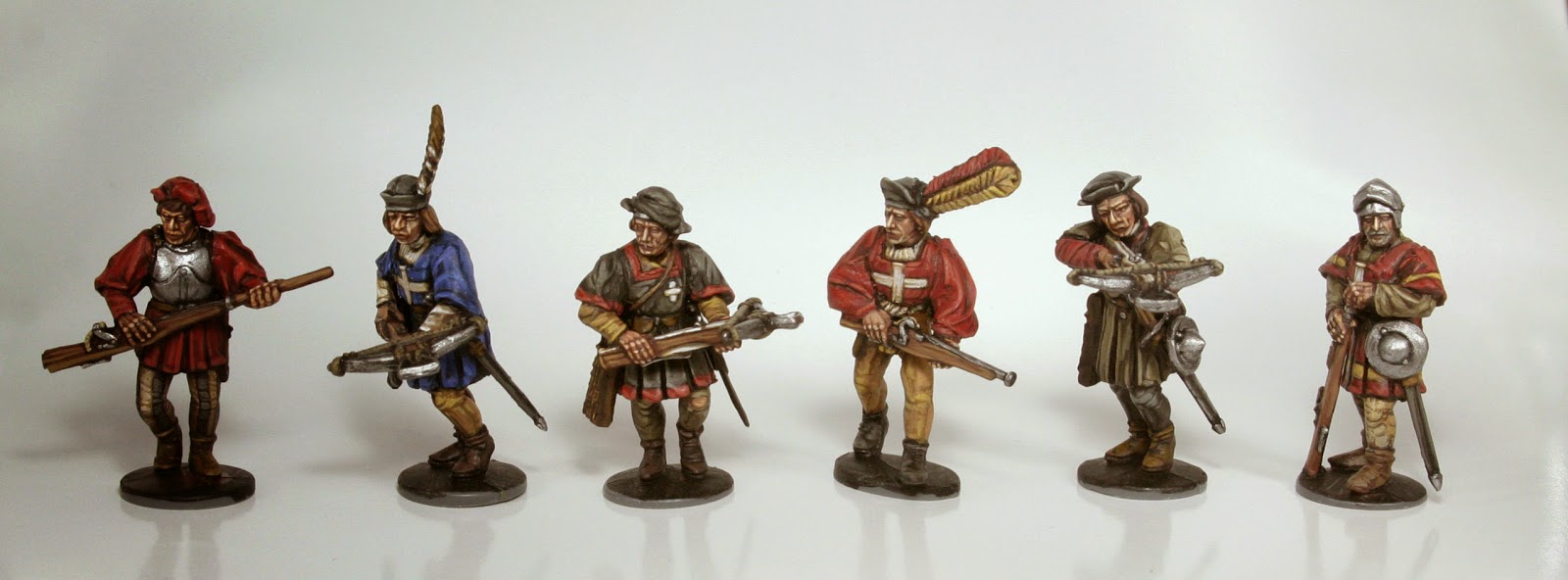David and Bethsabee, Le rassemlement des chevaliers c.1517-1520
Gendarmes and Archers - note older armour of the archers
With some long awaited leave I have begun work an equally long awaited project; French Ordonnance Archers.
Not to be confused with the 'Franc Archer'which, if you're interested an earlier blog post covers this subject; Franc Archers of Picardy
Here I'm considering cavalry,or rather the Archer and Coustillier - the remainder of the combatant French lance after the man at arms.
My period of interest, as you may have guessed is 1513, in this post I hope to summarise my findings on the subject and give you a look at some early work in progress on some figures.
David and Bethsabee, Le rassemlement des chevaliers c.1517-1520
Archers and Coustillier
To any painter or gamer interested in the Italian Wars this troop type soon proves itself to be a an enigma, so in my usual manner I have tried to gather as much as I can before committing to the brush with any confidence.
Depending on what rules or army list you look at Ordonnance Archers are deemed as medium cavalry, heavy cavalry or an early dragoon, the reasoning being that their armament and use is somewhat difficult to pin, this is due to both their organisation and the period or campaign that you may be interested in.
They began life as a mounted archer as part of the French lance, as time moves into the early to mid sixteenth century their chief armament changes in line with the arms race and their role on the battlefield, they soon do away with the bow to replace it with a light / demi-lance, there is no exact point in time that this happened, it was organic.
Equally, their role on the battlefield changed from support cavalry to eventually being part of the 'en haye' line of shock gendarmes, possibly in the first line, possibly in the second, it varies, the fact is they were used as required by topography, generalship, doctrine and availability.
For a collector and wargamer I'd say representation of these troops comes down to the following considerations;
- Base with gendarmes or separately
- arm with bow, lance, crossbow, arquebus or a mixture
- heavy, medium or light armour
I've researched this subject on and off since my interest in the period began my favoured resource is Renaissance France at War by David Potter from which I will briefly quote;
'Archers remained integral to the formation of the gendarmerie. Companies of men at arms had originally been designed to provide combined forces of cavalry and archers - the proportion of archers to men at arms varied widely - in the early years of the 15th C.
Bournonville's companies were fairly evenly balanced. From 1498 each lance was to include one man at arms and two archers. With the reorganisation of pay in 1533-4 lances would contain 100 men at arms and 150 archers. At what stage did archers evolve from real bowmen to slightly less heavily armed cavalry men? Balsac's treatise of the 1490's assumes that archers should be just that and deplored that so many 'cannot shoot'. But there are records of companies of archers actually wielding their bows in the Italian wars. In 1515 the King (Louis XII) decreed that the main cities should maintain armourers to manufacture bows for the archers of the ordonnances and that captains should ensure that there would be 'a good number of archers and crossbowmen drawing the bow well from the saddle or on foot.'
This requirement was repeated (by Francis I) in 1526.The archers have been described as 'second class' or 'medium' cavalry, armed slightly less expensively than the men at arms but sharing the same social prestige of the gendarmerie and crucially lighter and more flexible. Their task was to follow the first wave of attack and in skirmishing, not unlike the chevau-legers.'
Company of Beraud Stuart, seigneur d'Aubigny c.1509?
Gendarmes are depicted left and archers with bows on the right.
Reading this it does make me wonder whether 'Argoulets' (mounted crossbowmen / arquebusiers) were not a troop type but merely missile armed ordonnance archers ?
With this in mind I then considered views from some fellow enthusiasts and friends of this blog as to how to approach these troops in terms of appearance and use;
Officially the composition of the 'Lance' did not change at all, at least between 1445 and some point in the 1520s that I'm not certain of. Unofficially is a different matter and certainly there was also a change in the 'who', which resulted in the 'Archers' becoming filled with people who could not be Gendarmes, for a variety of reasons. This was far more pronounced in the early 16th Century than it was in the 1470s, when this change was just becoming noticeable and commented upon. By 1513 I suspect there were few 'Archers' who weren't of an equivalent social class to most of the Gendarmes, but were either too young, or couldn't get the kit together to be paid as one.
In a way it wasn't much different with what was going on in the English army of the time. Instead of the earlier mass of generic 'Men at Arms', which covered anyone with a fair to full amount of armour, who didn't carry a bow, a division between 'demi-lances' and 'true' Men at Arms, like the 'Gentlemen Pensioners', became increasingly commented on after 1485. It probably started earlier, but we just don't have the documents to support that before Henry VII.
In the French army the 'Archers' already existed as the most numerous group of the 'not fully armoured mounted men', so what would have been called demi-lancers elsewhere, were called 'Archers' in French service.
Jean Marot, La voyage de Genes (Louis XII's Genoa Campaign 1507), guard archers can be seen dismounted in the middle distance.
What they did is a different matter and quite confusing as you've found out. In battle they were seemingly separated from the Gendarmes and in 1495 still dismounted to use their bows and crossbows to support the attack of the Gendarmes. They also seem to have been increasingly used as 'heavy cavalry' too, as well as performing 'light cavalry' roles in lieu of there actually being any light cavalry. At some point between 1495 and 1520-ish, the bow and crossbow were completely ditched and they all had 'lances' .
I can't give a concrete answer, but if it was me, I would divide a 'company' into a ratio of; one unit of Gendarmes, to two of Archers, each unit being the same strength. What few illustrations survive of that period show the Archers as carrying bows, but as none of them concentrate on the Archers as a subject in their own right, it is difficult to see if their front ranks are lance-armed or not.
However the Coutilier, Coutilleur, Gros Varlets, Valets de Guerre, or whatever they were actually called, still existed, but are the 'invisible men' of the companies. These were armed with light spears or demi-lances and depending on what you believe their role to be, can either back the Gendarmes 1:1, or be divided between the two units of Archers in the same proportions.
I believe that the 'Coutilier' just became absorbed by the 'Archers', especially as their roles became increasingly similar, or perhaps even that lance-armed Archers steadily replaced them. This pretty much gives you the excuse to field some of your 'Archers' as lance-armed however.
The only other option that springs to mind is that they at some point carried light lance and bow. Bows could be slung when mounted and the lance used, while the lance could be left with the horse-holders if they dismounted. If they were increasingly used as cavalry, the bow would become redundant and eventually just not be carried at all. The French weren't exactly short of other missile troops, so 'lancers' might have been far more useful.
For 1513 though, I honestly don't know. Change is usually a gradual thing, so if we have 1 gendarme, 1 'lancer' and 2 'bowmen' at the end of the 15th Century and 1 gendarme and 3 'lancers' in the 1520s, it is possible that in 1513 it might be a case of 1 gendarme, 1-2 'lancers' and 2-1 'bowmen' being a rough ratio, despite all of the latter being called 'Archers' throughout.
Stephane Thion (friend of Army Royal)
The 20th January 1514 ordnance tell us that a company count 8 horses : 4 for the men at arm and 4 for the 2 archers. The 2 more horses will be "garnis de coustilliers" (mounted by coustilliers). Which mean that a company count 3 men paid by the king : one men at arm and 2 archers and up to 5 men (1 page, one valet and op to 3 coustilliers) which are not paid and so, not intended to fight.The page and valet are a young men of 17 or 18 years old, not in age to be a gendarme or archer but who will train with the bow. Here are some articles, in french, of this ordinance :
« toutes les compagnies de ses ordonnances soient fournies, entières et complètes d’hommes d’armes et archers, en tel nombre qu’il leur est ordonné, garnis de coutilliers ainsi qu’il appartient. (…) Ils tiendront huit chevaux pour lance fournie : c’est à savoir hommes d’armes, quatre, et les deux archers, quatre ou tel nombre qu’il leur plaira, à la discrétion toutefois du capitaine ou lieutenant ».
« Dorénavant, lesdits hommes d’armes ne tiendront aucuns valets ou pages s’ils ne sont de l'âge de dix-sept ou dix-huit ans, et au dessus : lesquels ils feront apprendre à tirer de l’arc, pour les mettre és ordonnances, si bon leur semble, quand ils seront en âge compétent pour servir ».
This ordinance order the wear of livery for archer, coustilliers and pages (which also means that it archer uses already to wear livery of their captain but not always), in order to recognise soldiers who robber and llot :
« Le roy ordonne que les capitaines desdits gens de guerre fassent toujours porter à tous archers, coustilliers et pages de leurs compagnies hoquetons à leur devise, tant à la ville qu’aux champs : et sera la livrée de chacun capitaine envoyée par les sénéchaussées et bailliages, à fin que quand ils feront les maux, que l’on puisse connaître de quelle compagnie chacun sera, pour en faire réparation ».
An other ordinance of the same date tell us than cities have to recruit archers (bowmen) use to archery and shooting with crossbow, from foot or horse :
« tirant bien à l’arc, et des arbalétriers qui soient bons pour tirer soit à cheval ou à pied ».
Now, here are the scarce evidence of archers equipment. As you write : Archers could be armed with crossbow from at least 1465. And there is an example, in 1500, of an archer firing crossbow from horse :
« un archer de la compagnie du seigneur de Saint-Prest, avec une arbalète bandée, pour plus droit assener quelqu’un de ces Allemands, lâcha la rêne de la bride de son cheval, et là, hasarda tant sa vie, sous l’assurance de la conduite de celui-ci, qu’entre ses ennemis soudainement l’emmena, lequel à coups de hallebardes fut sur le champ assommé ».
They can be armed with demi-lance, like an archer of the company of Bayard in 1509 who fight with such an armed against a stradiote.
In these years, the main role of archers is to be "coureurs" (runners). So i think, for such a mission, they will be mainly armed with demi-lances, the others being armed with crossbow. I think archers would be equipped with bow only for sieges. For example, we can see the archers of the king with bow during the siege of Genes in 1507. [see above]
However, in 1509, distances are mainly estimate "à la portée de jet d'arc" (in bow firing range). So some archers will probably be armed with bow when necessary.
BUT at Ravenna, in 1512, archers and guidons are grouped in a single light horse formation wich probably fought with demi-lance (the arm they use is not written in the relations of the battle, so it is a supposition). However, at Ravenne, the archers de la garde (of the guards) fought with their mace and not with demi-lance. Which can be interpreted as being armed with mace and bow rather than demi-Lance....
Finally, on pages, valets and coustilliers : they will usually not fight but there is some examples of coustilliers and valet bringing prisonners (like in this relation of 1499) :
« Tel homme d’arme français y avait, qui cinq ou six Lombards à sa merci qu’ils tenaient prisonniers ; tel archer, quatre ou cinq ; tels coutilliers et valets, deux ou trois ».
I suggest you have one man at arms, 2 archers in livery armed mainly with demi-lance and some with bow. I have chose to add a bow on the back of some demi-lances. And you can add some pages, valet, and coustilliers at will but it is not necessary.
Daniel S ( TMP Renaissance contributor)
The mounted archers were as far as I can tell never mounted crossbowmen, Potter makes an error when he refers to them as such when referring to the 1515 regulations. Having read the original document it is so obvious that I suspect that it is a case of an unintentional editing error while reworking the text or a change made by an editor rather than Potter misunderstanding the original text.
Archers were armed with longbow/warbow and dismounted to fight in battle. (Ravenna 1512 is a good example of this as is Fornovo) They always possessed some ability to fight mounted but were not fit to face heavy infantry or true cavalry on their own.
The change from mounted bowman to lancer is sadly obscured by the gaps in the sources. Don't have my notes next to me but IIRC the first reference to Archers fighting with lance is to be found in the 1530's and it took even longer for the regulations to reflect this change.
My personal theory is that the massive losses at Pavia finally ended the French use of the bow but an alternate possibility is that they were pressed into service as emergency cavalry during the numerous charges against the Swiss during the battle of Marignano 1515.
Personally I would field the archers on foot up to 1515, between 1515 and 1525 dual use but without lance and post-1525 as lancers.
Summary
Only one source and a few opinions but I hope this represents a fairly reasoned view. There's a lot to consider but some interesting similarities, so for 1513 I have decided to opt for;- archers based separately from the gendarmes; I like the notion of the gendarmes being the first wave and archers following up, it seems to make sense in terms of ability and lighter armour and equipment for archers to mop up and exploit gaps made after the initial shock.
- medium to light armour for the archers and light to none for the coustilliers, armour to be older harnesses or of munition quality.
- arm with a mix of demi-lance, mace, and bow and crossbow, some coats in livery.
I'm tempted to also base a unit of dismounted archers and a horse holder, not sure - how would you represent this in a wargame?
For reference, English mounted archers are just that, the word archer in the primary sources of the 1513 campaign appears interchangeable as mounted or dismounted, it was simply a way to move them around the battlefield quickly, they did not fight on horseback and for good measure, demi-lances are very clearly identified as are heavy cavalry.
Anyway, here are my first efforts;
The figures are from the Perry mounted men at arms set with Foundry (Perry sculpted) head swaps from their Landsknecht range as well as additional plumes taken from the Perry Swiss heads. All heads are drilled and pinned for extra stability. In addition I have also sculpted skirted coats which I'm quite pleased with.
In adopting this approach there is a balance between the older harness and the renaissance dress which distinguishes these from the gendarmes. When I come to the bow armed troops I may also sculpt riding boots.
This unit will take some time as I will base bow armed men with these lance armed figures, the forthcoming Perry light cavalry box will help me here so there will be a delay and more WIP's to come but I hope you have enjoyed my essay on the Ordonnance archer of 1513.
Cheerio for now and Merry Christmas to you and yours.
Stuart













